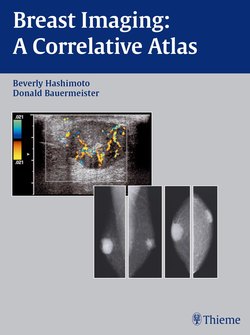Читать книгу Breast Imaging - Beverly Hashimoto - Страница 16
На сайте Литреса книга снята с продажи.
ОглавлениеCase 2
Case History
A 39-year-old woman with new left breast lump. Left breast sonography is initially performed. As a result of the sonogram, a mammogram has been done.
Physical Examination
• left breast: 5 cm palpable lump in the upper inner quadrant
• right breast: normal exam
Mammogram
Mass (Fig. 2–1)
• margin: circumscribed
• shape: oval
• density: fat-containing
Figure 2–1. At the 9:00 position of the left breast, there is a well-defined oval fat-containing mass with heterogeneous density (arrows). (A). Left MLO mammogram. (B). Left CC mammogram.
Ultrasound
Frequency
• 10 MHz
Mass
• margin: well defined
• echogenicity: heterogeneous
• retrotumoral acoustic appearance: no shadowing
• shape: ellipsoid (Fig. 2–2)
Figure 2–2. Left radial breast sonogram: The palpable lump corresponds to a well-defined, oval, solid mass of heterogeneous echogenicity. The peripheral portion of this mass is isoechoic to fat (arrows) and the central portion is hyperechoic (arrowheads). This mass corresponds to the lesion identified in Figure 2–1.
Pathology
• hamartoma
Management
• BI-RADS Assessment Category 2, benign finding
Pearls and Pitfalls
1. Hamartoma is a benign tumor that consists of mature tissues normally present in the breast. However, usually one element dominates the mass. Mammographically, the mass is well defined but the density of the mass varies with its composition. If the mass does not have much fat, then it may be completely radiopaque. However, if the mass is a mixture of fat and other soft tissues, then it will be mixed density as in this case. If the mass is completely radiopaque, then the differential diagnosis is fibroadenoma, cyst, or carcinoma. If the mass has mixed density, then the mammogram is diagnostic of hamartoma.
2. Sonographically, hamartoma has a variety of appearances. The individual components of the tumor should sonographically match their corresponding normal elements within the breast. The fatty component is isoechoic to fat and the fibroglandular elements are hyperechoic to fat.
Suggested Readings
1. Adler DD, Jeffries DO, Helvie Mak. Sonographic features of breast hamartomas. J Ultrasound Med 1990;9:85–90.
2. Altermatt HJ, Gebbers J-O, Laissue J-A. Multiple hamaratomas presenting as discrete breast mass. Can Assoc Radiol J 1992;43:218–220.
3. Anderson I, Hildell J, Linell F, et al. Mammary hamartomas. Acta Radiol 1979;20:712–720.
4. Beatty SM, Orel SG, McCarthy DM, et al. Breast hamartomas: MR appearance. Breast Dis 1995;8:275–281.
5. Crothers JG, Bjkutler NF, Fortt RW, et al. Fibroadenolipoma of the breast. Br J Radiol 1985;58:191–202.
6. Evers K, Yeh I-T, Troupin RH, et al. Mammary hamartomas. The importance of radiologic-pathologic correlation. Breast Dis 1992;5:35–43.
